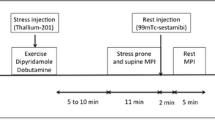Abstract
Feasibility of simultaneous 2D-Echo and SPECT Tc99m Sestamibi imaging during dobutamine infusion was evaluated in a female population with suspected coronary artery disease and scheduled for diagnostic coronary angiography. A total of 49 consecutive subjects were studied. Patients under continuous ECG and 2D-Echo monitoring underwent standard dobutamine infusion at increasing doses to a diagnostic end-point. Tc99m Sestamibi was administered at the peak of the dobutamine effect. With this approach, 35 patients were identified correctly by 2D-Echo (Sensitivity = 60.1%; Specificity = 83.3%; Agreement = 71.4%; k = 0.43). Perfusion imaging with Tc99m Sestamibi resulted in correctly identifying 41 patients (Sensitivity = 83%; Specificity = 84%; Agreement = 83.6%; k=0.67). Combining information obtained from the two tests resulted in increased specificity (92%) and decreased sensitivity (64%). Simultaneous assessment of perfusion and function with Tc99m Sestamibi and 2D-Echo imaging during dobutamine administration is easily performed without added risk or discomfort to the patient. Tc99m Sestamibi appeared to be slightly superior to 2D-Echo for the detection of CAD in this population, but the difference does not reach conventional statistical significance. The combined use of the two independent tests did not substantially improve the diagnostic accuracy of each method.
Similar content being viewed by others
References
Eaker ED, Packard B, Thom TJ. Epidemiology and risk factors for coronary heart disease in women. Cardiovasc Clin 1989; 19 (3): 129–45.
Elveback LR, Connolly DC, Melton LJ. Coronary heart disease in residents of Rochester, Minnesota. VII. Incidence, 1950 through 1982. Mayo Clin Proc 1986; 61 (11): 896–900.
Dittrich H, Gilpin E, Nicod P. Acute myocardial infarction in women: influence of gender on mortality and prognostic variables. Am J Cardiol 1988; 62 (1): 1–7.
Fiebach NH, Viscoli CM, Horwitz RI. Differences between women and men in survival after myocardial infarction: biology or methodology? JAMA 1990; 263 (8): 1092–6.
Greenland P, Reicher-Reiss H, Goldbourt U. In-hospital and 1-year mortality in 1,524 women after myocardial infarction: comparison with 4,315 men. Circulation 1991; 83 (2): 484–91.
Lerner DJ, Kannel WB. Patterns of coronary heart disease and mortality in the sexes: a 26 years follow-up of the Framingham population. Am Heart J 1986; 111 (2): 383–90.
Tofler GH, Stone PH, Muller JE. Effects of gender and race on prognosis after myocardial infarction: adverse prognosis for women, particularly black women. J Am Coll Cardiol 1987; 9 (3): 473–82.
Friedman TD, Greene AC, Iskandrian AS, Hakki AH, Kane SA, Segal BL. Exercise Thallium 201 myocardial scintigraphy in women: correlation with coronary artery arteriography. Am J Cardiol 1982; 49: 1632–7.
LaCanna P, Giubbini R, Metra M et al. Valore dell'angiocardioscintigrafia di primo transito nella diagnosi di malattia coronarica in donne con dolori toracici ed anomalie della ripolarizzazione di tipo ischemico. Cardiologia 1988; 33: 151–9.
Chatterjee K. ‘Dobutamine, a ten year review.’ New York: NCM, 1989.
Sawada SG, Segar DS, Ryan T, Brown SE, Dolan AM, Williams R, Armstrong NS, Feigenbaum H. Echocardiographic detection of coronary artery disease during dobutamine infusion. Circulation 1991; 83: 1605–14.
Kahn JK, McGlie I, Akers MS, Sills MN, Faber TL, Kulkarni PV, Wilkerson JT, Corbett JR. Quantitative rotational tomography with 201 Tl and 99m Tc 2-Methoxy Isobutyl Isonotrile, a direct comparison in normal individuals and patients with coronary artery disease. Circulation 1989; 79: 1282–93.
Altman DG. Practical statistics for medical research. London: Chapman and Hall, 1991: 404–8.
Ayanaz JZ, Epstein AM. Differences in the use of procedures between women and men hospitalized for coronary heart disease. N Engl J Med 1991; 325 (4): 221–5.
Steingart RM, Packer M, Hamm P. Sex differences in the management of coronary artery disease: survival and ventricular enlargement investigators. N Engl J Med 1991; 325 (4): 226–30.
Wenger NK. Gender, coronary artery disease, and bypass surgery. Ann Intern Med 1990; 112: 557–8.
Sketch MN, Mohiuddin SM, Lynch JD, Zencka AE, Runco V. Significant sex differences in the correlation of electrocardiographic exercise testing and coronary angiograms. Am J Cardiol 1975; 36: 169–73.
Berthe C, Pierard LA, Hienaux M, Trotteur G, Lempereur P, Cardier J, Kulbertus HE. Predicting the extent and location of coronary artery disease in acute myocardial infarction by echocardiography during Dobutamine infusion. Am J Cardiol 1986; 58: 1167–72.
Lane RT, Sawada SG, Ryan T, Armstrong WF, Feigenbaum H. Dobutamine stress echocardiography as a predictor of perioperative cardiac events. Circulation 1989; 80 (suppl II): II-67.
Previtali M, Lanzarini L, Ferrario M, Tortorici M, Mussini A, Montemartini C. Dobutamine versus dipyridamole echocardiography in coronary artery disease. Circulation 1991; 83 (suppl III): III-27-31.
Mason JR, Palac RT, Freeman ML, Virupannavar S, Loeb HS, Gunnar EKRM. Thallium scintigraphy during Dobutamine infusion: non exercise-dependent screening test for coronary disease. Am Heart J 1984; 107: 481–5.
Forster T, McNeil AJ, Salustri A, Reijs AEM, El-Said EM, Roelandt JRTC, Fioretti PM. Simultaneous dobutamine stress echocardiography and technetium 99m isonitrile single photon emission computed tomography in patients with suspected coronary artery disease. J Am Coll Cardiol 1993; 21: 1591–6.
Pennell D, Underwood S, Swanton R, Walker M, Ell P. Dobutamine thallium-myocardial perfusion tomography. J Am Coll Cardiol 1991; 18: 1471–9.
Kiat H, Maddahi J, Friedman J, Berman DS. Comparison of Tc99m methoxy isobutyl isonitrile with Thallium 201 imaging by planar and SPECT techniques for assessment of coronary disease. Am Heart J 1989; 117 (1): 1–11.
Author information
Authors and Affiliations
Rights and permissions
About this article
Cite this article
Slavich, G.A., Guerra, U.P., Morocutti, G. et al. Feasibility of simultaneous Tc99m sestamibi and 2D-echo cardiac imaging during dobutamine pharmacologic stress. Int J Cardiac Imag 12, 113–118 (1996). https://doi.org/10.1007/BF01880742
Accepted:
Issue Date:
DOI: https://doi.org/10.1007/BF01880742




